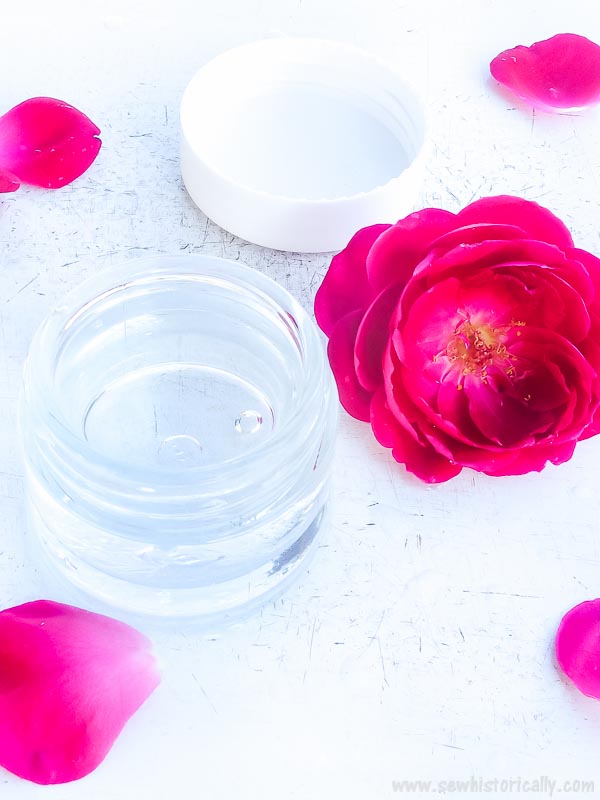Avoid toxic chemicals and make a simple homemade lotion with just 2 ingredients: rosewater & glycerin. Rosewater glycerin lotion has been popular since the Victorian era.

Victorian and Edwardian ladies used rosewater glycerin lotion as everyday lotion before applying face powder and as mild face toner after washing their face.
Related: Face Powder And Make-up – Victorian Beauty Routine
Almond cold cream ‘is troublesome to make and rather expensive, and it is perhaps no better for the purpose than glycerine.’ (Henley’s Twentieth Century Formulas, Recipes And Processes, 1914)
Rosewater glycerin lotion was also used to remedy dry skin, to protect the hair from sun damage and as hair wave lotion. Below are 7 Victorian & Edwardian rosewater glycerin lotion recipes – sorted by strength.
Related: Homemade Cold Cream
What Is Glycerin?
Glycerin, also called glycerol, is a natural humectant, a type of moisturizing agent. Glycerin has been popular for the skin and hair since the Victorian era. And it’s still a popular ingredient in lotions and moisturizers. Glycerin moisturizes the skin and helps to heal wounds.
However, glycerin should never be used on its own because it’s very sticky. Therefore, always dilute glycerin with rosewater or distilled water.
‘The mistake is often made of applying […] [glycerin] too freely, its “stickiness” being unpleasant, and it is best to dilute it largely with water. Such a lotion may be made by mixing’ glycerin with rosewater. (Henley’s Twentieth Century Formulas, Recipes And Processes, 1914)
Did You Try It?
I tried Glycerin Lotion No. 3. I just stirred together rosewater and glycerin with a spoon: The glycerin dissolves easily in rosewater.
The glycerin lotion looks like water (see pictures), smells strongly of roses – because of the rosewater – and it feels a little sticky. So, I think Victorian rosewater glycerin lotion works better as face lotion than as hand lotion.
Victorian Rosewater Glycerin Lotion
Glycerin Lotion For The Face & Hands
Glycerin Lotion No. 1 (Encyclopedia Of Practical Receipts And Processes, 1872)
- 1 part glycerin
- 19 parts distilled or pure soft water
‘A good strength for daily use as a cosmetic wash, or as a vehicle for other ingredients, for which purpose it is greatly preferable to milk of almonds; also as a lotion to allay itching and irritation of the skin, prevent chaps, excoriations, the effects of weather, climate, etc.. It is likewise applied to the hair instead of oil.’
Glycerin Lotion No. 2 (Encyclopedia Of Practical Receipts And Processes, 1872)
- 1 part glycerin
- 17 parts water
‘A proper strength when more marked effects are desired; as in chapped hands, lips, and nipples, obstinate excoriations, abrasions, chafings, sunburns, persistent roughness or hardness of the skin, etc.’

Glycerin Lotion No. 3 (Henley’s Twentieth Century Formulas, Recipes And Processes, 1914)
- 1 part glycerin
- 9 parts rosewater
‘Plain water may, of course, be used as the diluent, but a slightly perfumed preparation is generally considered more desirable. The perfume may easily be obtained by dissolving a very small proportion of handkerchief “extract” or some essential oil in the glycerine, and then mixing with plain water.’
Related: Victorian Perfume, Deodorant & Perfumed Body Powder
Glycerin Lotion No. 4 (Encyclopedia Of Practical Receipts And Processes, 1872)
- 1 part glycerin
- 5 1/2 parts water
‘This is adapted for use in obstinate cases, or when still more rapid effects are desired; also as an application to burns and scalds.’
Glycerin Hand & Nail Lotion (Health And Beauty Hints, 1910)
- 1 part glycerin
- 2 parts rosewater or water
‘If it is necessary to plunge the fingers into strong soap water […] After washing and wiping, the hands should be rubbed with a mixture of glycerine and rosewater […] Plain water may be substituted for rose’.
Glycerin Lotion For The Hair
Glycerin Hair Lotion – To Prevent Hair Being Sunburnt (Health And Beauty Hints, 1910)
- 1 tsp glycerin
- 1/2 pint water
‘At the first appearance of any change of shade it [the hair] must be given a touch of glycerine and water. […] it does supply a little food that serves as protection. […] The application should be used morning and night, applying it by putting a little in the palm of one hand, rubbing the two together, and then patting the head evenly; this is to be done after combing, and just before making the coiffure.’
Glycerin Wave Lotion (Chicago Tribune, 1902)
- 1 part glycerin
- 1 – 2 parts rosewater or water
‘Glycerin and water will not mix well, but if you will combine them, half and half, and wet the hair you will be rewarded with a little stiff wave which is better than no wave at all. Glycerin, with twice as much rosewater added, will make a fairly good hair waver.’
Related: Edwardian No-Heat Zig-Zag Waves
Please Pin It!